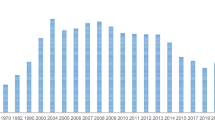Abstract
This paper uses a cross-temporal meta-analysis to summarize information about the ideal number of children, gender composition, and timing of childbirths during the years 1980–2015 in China. This allows a comparison between ideas about the ideal number of children and actual childbearing behavior. The results show that fertility and the ideal number of children both decreased, but that fertility was higher than the ideal number of children before 1990, and that fertility was lower than the ideal number of children thereafter. Gender preference weakened; however, the preference for sons decreased slowly. The timing of childbearing became significantly later over the study period, while the ideal age of childbearing remained relatively stable. The findings provide evidence to aid understanding of the changes in childbearing in China.

Data source: Hou et al. (2015)

Data source: Hou et al. (2015)

Data source: Hou et al. (2018)

Data source: Hou et al. (2018)

Data source: Hou et al. (2018)

Data source: Zhang and Hou (2016)

Data source: Zhang and Hou (2016)
Similar content being viewed by others
References
Bongaarts, J. (2001). Fertility and reproductive preferences in post-transitional societies. Population and Development Review,27(2), 260–281.
Chen, W. (1995). China’s low fertility rate. Social Sciences in China,2, 75–96. (in Chinese).
Chen, W. (2016). China’s demographic estimation using the generalized stable population model. Population Journal,38(01), 5–13. (in Chinese).
Choe, M. K., Retherford, R. D., & Kim, S. (2004). Very low fertility in South Korea: Patterns and prospects. In Paper presented at the 2004 Annual Meeting of the Population Association of America.
Department of Population and Employment Statistics National Bureau of Statistics. (2016). China population and employment statistics yearbook 2016. Beijing: China Statistics Press.
Department of Population and Employment Statistics National Bureau of Statistics. (2018). China population and employment statistics yearbook 2018. Beijing: China Statistics Press.
Harknett, K., & Hartnett, C. S. (2014). The gap between births intended and births achieved in 22 European countries, 2004‒07. Population Studies,68(3), 265–282.
Hou, J., Gu, B., & Zhang, Y. (2018). The dynamic relationship between gender preferences for children and the sex ratio at birth, 1979–2017. Social Sciences in China,10(86–101), 206. (in Chinese).
Hou, J. W., Huang, S. L., Xin, Z. Q., Sun, L., Zhang, H. C., & Dou, D. H. (2015). A change in the desired fertility of the Chinese population: 1980–2011. Social Sciences in China,36(1), 78–97, 206.
Knodel, J., Ruffolo, V. P., Ratanalangkarn, P., & Wongboonsin, K. (1996). Reproductive preferences and fertility trends in post-transition Thailand. Studies in Family Planning,27(6), 307–318.
Ma, X., & Hou, Y. (2008). The only child and “double only” family fertility intention and change. Population & Economics,1(15–18), 6. (in Chinese).
Ma, Z., & Wang, J. (2009). “Children’s portfolio preference” and selective birth: Changes in China’s fertility level and changes in children’s combination sequence in the 1990s. Population Research,33(05), 23–35. (in Chinese).
Noack, T., & Østby, L. (2002). Free to choose–but unable to stick to it? Norwegian fertility expectations and subsequent behaviour in the following 20 years. In E. Klijzing & M. Corijn (Eds.), Dynamics of fertility and partnership in Europe: Insights and lessons from comparative research (pp. 103–116). New York, Geneva: United Nations.
Régnier-Loilier, A., & Vignoli, D. (2011). Fertility intentions and obstacles to their realization in France and Italy. Population,66(2), 361–389.
Song, J., & Chen, F. (2010). Reproductive behaviors and preferences of China’s urban youths: Deviation and determinants. Chinese Journal of Population Science,5, 103–110. (in Chinese).
Spéder, Z., & Kapitány, B. (2009). How are time-dependent childbearing intentions realized? Realization, postponement, abandonment, bringing forward. European Journal of Population,25(4), 503–523.
Twenge, J. M. (1997a). Changes in masculine and feminine traits over time: A meta-analysis. Sex Roles,36(05), 305–325.
Twenge, J. M. (1997b). Attitudes toward women, 1970–1995: A meta-analysis. Psychology of Women Quarterly,21(01), 35–51.
Yang, J. (2008). The deviation of will and behavior: A review of research on fertility desire and fertility behavior in developed countries and its enlightenment to China. Academia Bimestris,1, 27–37. (in Chinese).
Zhang, Y., & Hou, J. (2016). The actual and ideal fertility age of Chinese Population: 1994–2012. Population and Development,22(02), 2–11. (in Chinese).
Zheng, Z. (2013). The choice of having a second child and its implication for future family structure in China. In A. Buchanan & A. Rotkirch (Eds.), Fertility rates and population decline: No time for children?. London: Palgrave Macmillan.
Funding
This research was supported by 2015 The National Social Sciences Fund of China (15CRK008):“Study on the causes and influencing mechanism of the inconsistency between Ideal and actual childbearing in China”.
Author information
Authors and Affiliations
Corresponding author
Rights and permissions
About this article
Cite this article
Hou, J., Zhang, Y. & Gu, B. Ideal and actual childbearing in China: number, gender and timing. China popul. dev. stud. 3, 99–112 (2020). https://doi.org/10.1007/s42379-019-00039-0
Received:
Accepted:
Published:
Issue Date:
DOI: https://doi.org/10.1007/s42379-019-00039-0




